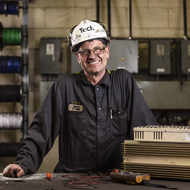At the Heart of Safety at Teck
Safety is a core value at Teck, and we believe we can operate without fatalities or serious injuries. This belief is at the heart of Courageous Safety Leadership (CSL), which was introduced in 2009 and is central to our safety strategy at Teck.
CSL is a journey—for each of us individually, within our teams, and for our company—one on which we are constantly strengthening our culture of safety. Here, we take a look at how CSL has evolved since being introduced at Teck, and where we’re headed with our current CSL programs: CSL4 and Introduction to CSL.
2009: Courageous Safety Leadership (CSL) first introduced at Teck
CSL transformed how we think about safety, making it clear that safety is a core value, and that it starts with each of us having the courage and responsibility to speak up. CSL is a values-based approach to safety that challenges existing beliefs and attitudes, and empowers every employee to be a safety leader. In CSL, we also learned about the ripple effect our safe work choices can have on our family, friends and coworkers.
2012: Courageous Safety Leadership, Next Steps (CSL3) developed
CSL3 renewed our focus on CSL and reminded us of key concepts. In CSL3, participants were introduced to the Swiss Cheese Model, where workplace hazards are compared to the holes in a slice of Swiss cheese. This model illustrates the many layers of safety that block the holes and prevent an incident from occurring; highlighting how every employee can add new layers to our safety systems to create a safer working environment.
Milestone: To date, over 16,000 employees and contractors have completed CSL and CSL3.
2016: Safety Culture Survey conducted
Teck’s first company-wide survey gathered insight and feedback from employees and contractors about our safety culture. More than 5,700 people completed the survey, providing a wealth of information on where we’ve made progress and where we must continue to improve. Outcomes, including a focus on safe production, were used in the development of CSL4.
2016 – Ongoing: CSL4: Exploring Our Culture of Safety rolled out
CSL4 provides an opportunity for teams to work together to advance our culture of safety, by exploring our safety journey to date, identifying safety strengths and opportunities, and looking at how safe production can be achieved.
Milestone: To date, almost 5,200 employees and contractors have completed CSL4.
Our Safety Accomplishments
Our safety performance has improved steadily since the introduction of Courageous Safety Leadership in 2009, both in the frequency of high potential incidents, and how often incidents are resulting in injury.


Where We Are Now
CSL4
In late 2016 we started rolling out the next phase of CSL, CSL4: Exploring Our Culture of Safety.
A key component of CSL4 is a team-based approach. CSL4 sessions are organized and attended by working teams—people who work together day-to-day—and are facilitated by their supervisor, with support from a CSL4 Champion and management.
“Supervisors are really doing a great job leading their teams through CSL4,” said Lawrence Watkins, Vice President, Health and Safety. “As a result, teams are having important conversations around our safety strengths, opportunities and safe production challenges.”
To date, almost 5,200 employees and contractors have participated in CSL4, with all employees and contractors expected to participate by the end of 2018.
Introduction to CSL
In 2017, development also began on Introduction to CSL, which will be rolled out to all new employees starting in late 2017 and into 2018. Combining components of CSL1 and CSL3, Introduction to CSL introduces new employees to key concepts related to CSL, embedding the culture of safety, and instilling safety as a core value.
Introduction to CSL also contains updated, refreshed and new content, sharing some of the positive change stories that have resulted over the course of Teck’s CSL journey.
Positive Change Story
One of the positive change stories shared during Introduction to CSL is from our Pend Oreille Mine in Washington state. There, Kim Caudill, an Underground Miner, played a critical role in speaking up about a dangerous task that had been done the same way for many years, causing potential for serious harm. Kim’s concern was brought forward to supervisors and mine management, and a Work Team Risk Assessment (WTRA) was performed. As a result, the process was re-engineered, making for a much safer work environment.


